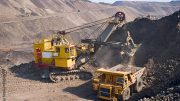Most investors don’t make a connection between tech and mining. But mining supplies the raw materials for the semiconductor industry, which is in the midst of a huge growth spurt.
As you probably know, interest in semiconductors has exploded over the last 12 months thanks to a boom in artificial intelligence.
If you’re unfamiliar with the link between the two, semiconductors have been likened to the ‘picks and shovels’ of the AI boom.
In other words, they are the vital tools needed to expand AI’s reach throughout the global economy.
For better or worse, corporations are rapidly adopting. This is an unstoppable trend that promises major disruption, especially within the white collar sectors like law, accounting, and finance while unleashing a productivity boon for corporations.
No one is immune from the threat of AI, but as they say, if you can’t beat them, join them.
The resource sector may not seem like an obvious choice to do that. But recall last year’s upset in gallium and germanium supplies. Both minerals are critical in semiconductor manufacturing.
China has a firm grip on global supply and used its dominance to retaliate against Western trade pressures in early 2023, imposing restrictions on exports of the minerals.
Given the country supplies almost 80% of the global market, the move created a major stir in the market.
A small handful of explorers surged on the back of these geopolitical rumblings.
But are there any other critical minerals set to play a key role in semiconductor manufacturing?
High purity alumina
Demand for high-purity alumina (HPA) is diverse and driven by two MAJOR growth drivers: renewables and artificial intelligence.
It’s a true ‘future-facing metal.’ Yet, few understand its important role.
According to Grand View Research, the global HPA market was valued at around US$3.2 billion in 2022.
However, that’s expected to grow at a compound annual growth rate (CAGR) of around 22% from 2023 to 2030.
HPA is an ultra-refined form of aluminium oxide with a purity exceeding 99.99%. Unrefined aluminum tends to contain small amounts of trace elements like silica and iron, which gives it vastly different properties from HPA.
But once these ‘impurities’ are removed, the magic of HPA begins to emerge. High transparency, chemical inertness, high thermal conductivity and resistance to thermal shock are some of the properties that make HPA ideal for semiconductor manufacturing.
The material is used to build the tiny wafers and insulating layers surrounding the chips.
Yet, this is not the only market for this unique commodity. It is transparent like glass but has far superior strength. This means it’s used for optical lenses, medical equipment and specialized windows.
In fact, purified alumina is so strong it’s used as ‘transparent armour’ for the military. Meanwhile, it’s perfect for making scratch-resistant camera lenses and smartphone screens.
HPA also plays a critical role in lithium-ion batteries. Here, it acts as something known as a ‘separator’ — a thin, porous membrane that divides the positive and negative electrodes (anodes and cathodes) in a battery cell.
Separating the electrodes also allows the free flow of ions during charging and discharging battery cycles.
This is critical for preventing short circuits in EV batteries, thereby eliminating the problem of spontaneous explosions that have plagued electric vehicles.
Yet, the biggest demand driver for high-purity alumina comes from the LED sector.
According to Grand View Research, this accounts for 49% of overall demand.
Selective commodities boom
Commodity markets offer enormous opportunities, especially those tied to minerals with unique properties and wide technological applications.
That’s a big change from the last commodity boom of the early 2000s.
Here, the focus was on bulk-tonnage iron ore and base metal operations, which fed a hungry Chinese infrastructure boom.
However, I believe investors will need to be much more targeted with their investment choices in the years ahead.
The coming resource boom may not be a tide that floats all boats as it did during the last cycle. Specific commodities will feature prominently, just like lithium has over the last few years.
And it is those companies that can value add and find a niche in the market that could benefit the most.
— James Cooper runs the commodities investment service Diggers and Drillers. You can also follow him on X @JCooperGeo.




Be the first to comment on "How critical minerals tie into the AI boom"